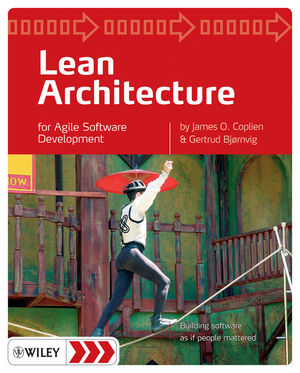Lean Architecture: for Agile Software DevelopmentISBN: 978-0-470-68420-7
Paperback
384 pages
June 2010
 Other Available Formats: Wiley E-Text
|
||||||
Preface.
1 Introduction.
1.1 The Touchstones: Lean and Agile.
1.2 Lean Architecture and Agile Feature Development.
1.3 Agile Production.
1.4 The Book in a Very Small Nutshell.
1.5 Lean and Agile: Contrasting and Complementary.
1.6 Lost Practices.
1.7 What this Book is Not About.
1.8 Agile, Lean ? Oh, Yeah, and Scrum and Methodologies and Such.
1.9 History and Such.
2 Agile Production in a Nutshell.
2.1 Engage the Stakeholders.
2.2 Define the Problem.
2.3 Focusing on What the System Is: The Foundations of Form.
2.4 Focusing on What the System Does: The System Lifeblood.
2.5 Design and Code.
2.6 Countdown: 3, 2, 1. . . .
3 Stakeholder Engagement.
3.1 The Value Stream.
3.2 The Key Stakeholders.
3.3 Process Elements of Stakeholder Engagement.
3.4 The Network of Stakeholders: Trimming Wasted Time.
3.5 No Quick Fixes, but Some Hope.
4 Problem Definition.
4.1 What's Agile about Problem Definitions?
4.2 What's Lean about Problem Definitions?
4.3 Good and Bad Problem Definitions.
4.4 Problems and Solutions.
4.5 The Process Around Problem Definitions.
4.6 Problem Definitions, Goals, Charters, Visions, and Objectives.
4.7 Documentation?
5 What the System Is, Part 1: Lean Architecture.
5.1 Some Surprises about Architecture.
5.2 The First Design Step: Partitioning.
5.3 The Second Design Step: Selecting a Design Style.
5.4 Documentation?
5.5 History and Such.
6 What the System Is, Part 2: Coding It Up.
6.1 The Third Step: The Rough Framing of the Code.
6.2 Relationships in Architecture.
6.3 Not Your Old Professor's OO.
6.4 How much Architecture?
6.5 Documentation?
6.6 History and Such.
7 What the System Does: System Functionality.
7.1 What the System Does.
7.2 Who is Going to Use Our Software?
7.3 What do the Users Want to Use Our Software for?
7.4 Why Does the User Want to Use Our Software?
7.5 Consolidation of What the System Does.
7.6 Recap.
7.7 "It Depends": When Use Cases are a Bad Fit.
7.8 Usability Testing.
7.9 Documentation?
7.10 History and Such.
8 Coding It Up: Basic Assembly.
8.1 The Big Picture: Model-View-Controller-User.
8.2 The Form and Architecture of Atomic Event Systems.
8.3 Updating the Domain Logic: Method Elaboration, Factoring, and Re-factoring.
8.4 Documentation?
8.5 Why All These Artifacts?
8.6 History and Such.
9 Coding it Up: The DCI Architecture.
9.1 Sometimes, Smart Objects Just Aren?t Enough.
9.2 DCI in a Nutshell.
9.3 Overview of DCI.
9.4 DCI by Example.
9.5 Updating the Domain Logic.
9.6 Context Objects in the User Mental Model: Solution to an Age-Old Problem.
9.7 Why All These Artifacts?
9.8 Beyond C++: DCI in Other Languages.
9.9 Documentation?
9.10 History and Such.
10 Epilog.
Appendix A Scala Implementation of the DCI Account Example.
Appendix B Account Example in Python.
Appendix C Account Example in C#.
Appendix D Account Example in Ruby.
Appendix E Qi4j.
Appendix F Account Example in Squeak.
F.1 Testing Perspective.
F.2 Data Perspective.
F.3 Context Perspective.
F.4 Interaction (RoleTrait) Perspective.
F.5 Support Perspective (Infrastructure Classes).
Bibliography.
Index.



